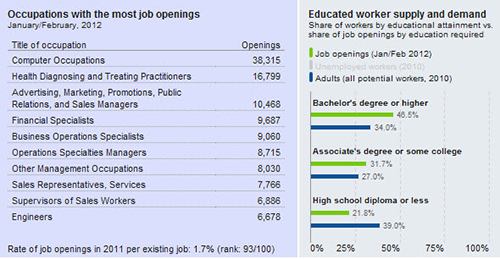To help fill the information needs of workforce and education stakeholders, CMAP has launched MetroPulse Jobs, an on-line data and information resource designed show past and projected employment by industry and occupation, as well as information on related training and education programs. By linking data on industries, occupations, and education and training providers, MetroPulse Jobs presents a clearer view of the supply and demand for workers, as well as information needed to target resources and help our region become more competitive in the global marketplace.
The region's economy depends on a workforce that meets employers' needs and can fuel innovation, making it critical that training and education programs equip individuals with the right skills and knowledge. To build a robust and ready labor pool, workforce and education decision makers need an understanding of which occupations are growing, what training is required for those occupations, and how the skills and training needs are changing as industries innovate. As GO TO 2040 shows, workforce and education stakeholders agree that improving access to and use of complete industry and labor market data and information is a priority. Without good data and information, the region is at risk of growing its "skills-mismatch" that sustains unemployment despite employers search for qualified workers. A recent Brookings Institute report investigated this issue in-depth and found that the greatest mismatch in the Chicago Metropolitan Service Area (MSA) is for individuals with a bachelor's degree. The report also shows which occupations have the most job openings.

Source: Brookings Institute "Education, Job Openings, and Unemployment in Metropolitan America." August 2012. Click image for larger version.
This analysis is helpful, but additional data and information is needed to know which specific industries are hiring and what specific degrees and other credentials are required for different positions. MetroPulse Jobs aims to address the need for detailed information by drilling into specific industries and occupations and the relationships between jobs and training. MetroPulse Jobs shows what training is associated with occupations and which occupations are in each industry. The new data portal maps workforce training providers connected to occupations in the freight cluster and, when data is available, shows the number of people that have completed programs over the last five years. Data and information currently available for the freight cluster through MetroPulse Jobs include:
- Historical and projected size of industries and occupations in the cluster.
- Linkages between industries and occupations.
- Education of existing workforce by occupation.
- Relative size of industries and occupations within the cluster.
- Percent of occupations within an industry.
- Percent of industry in the cluster.
- Location of industries and occupations by county and workforce investment area.
- Wages of occupations in the cluster.
- Education and training association with occupations.
- Location of training and education programs associated with the freight cluster, including those that are certified Workforce Investment Act (WIA) providers.
- Number of completers of education programs linked to freight clusters.
Data is presented in a variety of interactive visualizations that are easy to navigate. The site can help answer questions such as:
- Which industries employing welders show the most growth?
- What training is associated with being a cargo and freight agent? Which skills are required?
- Which community colleges' Logistics and Supply Chain Management programs are WIA-certified, and how many people have completed this program over the last five years?
- Which freight related occupations in the DuPage Workforce Investment Area provide the highest wages and are growing the fastest?
- Where are truck driving schools in Cook County located?
The first industry cluster featured on the site is the freight cluster, which builds off CMAP's recently released freight cluster drill-down. As CMAP publishes subsequent drill-down reports on manufacturing (winter 2012-13) and biotechnology (summer 2013), those datasets will be added soon thereafter (in spring 2013 and fall 2013, respectively). Please contact Annie Byrne (abyrne@cmap.illlinois.gov) if you would like to participate in a webinar about MetroPulse Jobs on Wednesday, October 3 at 10:00 a.m. Crain's Chicago Business is currently featuring data fromMetroPulse Jobs andthe drill-down report in an interactive infographic.
